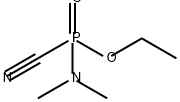타분 C화학적 특성, 용도, 생산
개요
Tabun is a nonpersistent organophosphorus nerve agent that
was first synthesized in 1936 by the German scientist
Dr Gerhard Schrader, who would later be known as ‘the father
of the nerve agents.’ Dr Schrader was developing new insecticides
when he accidentally discovered tabun, the first of the
nerve agents. During initial experiments testing tabun on
insects, Dr. Schrader and his laboratory assistant were exposed
to the vapors and quickly became ill. After learning of its
properties and improving its manufacturing, the German
government began synthesizing stockpiles of tabun in 1942
and had close to 13 000 tons by the end of World War II. The
Allies did not become aware of tabun or other German-made
nerve agents until the end of the war. Much of the German
stockpiles of tabun were destroyed by dumping into the sea
where it decomposes over time.
Due to their greater lethality, soman and sarin were eventually
favored over tabun by the Allied nations. However, the
ease of manufacturing tabun makes it a feasible option for countries that are beginning to establish a chemical weapons
capability. Due in part to the simplicity and widespread
knowledge about its synthesis, Iraq stockpiled and used tabun
against Iranian troops in 1984 in the first confirmed instance of
nerve agent use in theater.
화학적 성질
Liquid. Readily soluble
in organic solvents; miscible with water but readily
hydrolyzed; destroyed by bleaching powder, generating
cyanogen chloride. Combustible.
용도
Tabun is a nerve agent used in chemical warfare. It was the first
of the G series of nerve agents to be described and hence was
given the designation GA.
정의
tabun: A highly toxic colourless orbrown liquid, C
5H
11N
2O
2; r.d. 1.09;m.p. –50°C; b.p. 247.5°C. It is anorganophosphorus compound, ethylN,N-dimethylphosphoramidocyanidate.Tabun was discovered in1936 and belongs to the G-series ofnerve agents (GA). It was used byIraq in the Iran–Iraq war (1980–88).
일반 설명
Colorless to brown liquid with a faint fruity odor. Used as a chemical warfare agent.
공기와 물의 반응
Hydrolysis forms hydrogen cyanide.
반응 프로필
When heated to decomposition, GA. emits very toxic fumes of oxides of phosphorus and nitrogen. Avoid water and acids. Can react with oxidizing materials. [EPA, 1998].
위험도
Very toxic by inhalation, cholinesterase
inhibitor, amilitary nerve gas, fatal dose (man) 0.01
mg/kg.
건강위험
GA. is toxic by inhalation and by absorption through skin and eyes. The lethal dose for humans may be as low as 0.01 mg/kg. GA. is a nerve agent; it acts as a cholinesterase inhibitor. The median lethal dosage (respiratory) is 400 mg-minute/m3 for humans; the median incapacitating dosage is 300 mg-minute/m3. Respiratory lethal dosages kill in 1 to 10 minutes; liquid in the eye kills nearly as rapidly. Skin absorption great enough to cause death may occur in 1 to 2 minutes, but may be delayed for 1 to 2 hours.
화재위험
Extremely poisonous. (Non-Specific -- Poison A, Liquid) Keep away from sparks, flames, and sources of ignition. Keep out of water sources and sewers. Hydrolysis forms hydrogen cyanide. When heated to decomposition, GA. emits very toxic fumes of oxides of phosphorus and nitrogen. Avoid water and acids. Can react with oxidizing materials.
Safety Profile
Human poison by
inhalation, skin contact, and intravenous
routes. Experimental poison by ingestion,
inhalation, skin contact, subcutaneous,
intravenous, intraperitoneal, and
intramuscular routes. A nerve gas. Vapor
does not penetrate skin; Liquid does so
rapidly. The primary physiological action is
on the sympathetic nervous system, causing
a vasoparesis ('partial paralysis of the
vasomotor nerves, which control the
diameter of the blood vessels). Vapors when
inhaled can cause nausea, vomiting, and
diarrhea, which can be followed by muscular
twitclung and convulsions. Flammable when
exposed to heat or flame; can react with
oxidizing materials. When heated to
decomposition it emits very toxic fumes of
POx, CN-, and NOx. See also
PARATHION and CYANIDE.
잠재적 노출
GA is a highly persistent (may remain liquid for more than 24 hours) chemical warfare agent; military nerve gas. Nerve agents are more toxic and potent than insecticides. Note: If used as a weapon, notify United States Department of Defense: Army. Damage and/or death may occur before chemical detection can take place. Use M8 paper if available (Detection: yellow) or M256-A1 Detector Kit (Detection limit: 0.005 milligram per cubic meter).
운송 방법
UN2810 Toxic liquids, organic, n.o.s., Hazard Class: 6.1; Labels: 6.1-Poison Inhalation Hazard, Technical Name Required. Military driver shall be given full and complete information regarding shipment and conditions in case of emergency. AR 50-6 deals specifically with the shipment of chemical agents. Shipments of agent will be escorted in accordance with AR 740-32.
비 호환성
Tabun (GA) decomposes slowly in water; hydrolysis forms hydrogen cyanide. Under acid conditions, GA hydrolyzes to form hydrofluoric acid (HF). Raising the pH increases the rate of decomposition significantly. Rapidly hydrolyzed in basic solutions (Na2CO3, NaOH, or KOH) with a half-life of 1.5 minutes at pH 11 @25℃. GA and its hydrolysis products exhibit no significant phototransformations in sunlight. Tabun and its hydrolysis products are thermally stable at temperatures less than 49 ℃. Reacts with oxidizing materials. Tabun is destroyed by bleaching powder, but the reaction produces cyanogen chloride (CNCl). Decomposes within six months @ 60 ℃. Complete decomposition in 3.5 hours @ 150℃; may produce hydrogen cyanide, oxides of nitrogen; oxides of phosphorus; carbon monoxide; and hydogen cyanide. Contact with metals may evolve flammable hydrogen gas
타분 준비 용품 및 원자재
원자재
준비 용품






